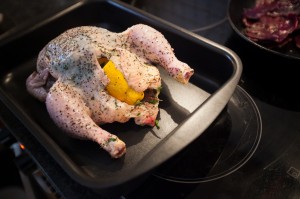The UK’s Food Standards Agency (FSA) has published the cumulative results from the first two quarters of its year-long survey of campylobacter on fresh chickens, which showed that 70 per cent of chicken sold in UK supermarkets were infected with the bacteria.

The FSA said tackling campylobacter was its “number one food safety priority” and it is spearheading a campaign to bring together the whole food chain to tackle the problem. Campylobacter is killed by thorough cooking; however it is the most common form of food poisoning in the UK, affecting an estimated 280,000 people a year. Poultry is the source of the majority of these cases.
Individual results by major retailer have also been published.
The FSA said results to date showed:
- 18 per cent of chickens tested positive for campylobacter above the highest level of contamination (Above 1,000 colony forming units per gram (>1,000 cfu/g). These units indicate the degree of contamination on each sample.)
- 70 per cent of chickens tested positive for the presence of campylobacter
- 6 per cent of packaging tested positive for the presence of campylobacter with only one sample at the highest level of contamination (>1,000 cfu/g)
Nearly 2,000 chickens sampled so far
In total, 1,995 samples of fresh whole chilled chickens have now been tested, with packaging also tested for most of these samples. Data showed variations between retailers but none were meeting the end-of-production target for reducing campylobacter.
The overall figures showed an increase in contamination from the first quarter to the second quarter. The FSA said this was most likely due to the second quarter’s samples being taken during the summer months when an increase in campylobacter is often seen because of the warmer weather.
This 12-month survey, running from February 2014 to February 2015, will test 4,000 samples of whole chickens bought from UK retail outlets and smaller independent stores and butchers.
‘These results show that the food industry, especially retailers, need to do more to reduce the amount of campylobacter on fresh chickens,” said Steve Wearne, FSA Director of Policy.
Mr Wearne said that although the FSA was only half-way through the survey, the results showed there was “a long way to go before consumers are protected from this bug”.
“If chicken is cooked thoroughly and preparation guidelines are properly followed, the risk to the public is extremely low,” Mr Wearne said. “There are signs that some retailers are starting to step up to their responsibilities. When more do, we will see the sustained improvements that will help prevent many of their customers getting ill,” he said.
Industry and retailer efforts to reduce bacteria
There have been some recent developments in industry and retailer efforts to tackle campylobacter. These include:
Marks & Spencer and its supplier, 2 Sisters Food Group, have recently developed a five-point plan, an integrated programme of interventions along the food chain to reduce levels of campylobacter. Asda and its supplier, Faccenda, have committed to an innovative new steam technology (SonoSteam) that has shown promising results in tests and is now being installed at the Faccenda factory for full scale, in line trials. Moy Park’s development of on-farm biosecurity, which has found cost effective ways of exceeding Red Tractor standards. A number of retailers have introduced ‘roast in the bag’ chickens which help limit cross-contamination by minimising the handling of the raw chicken in the home.
The FSA said it was likely that recent interventions to reduce the levels of campylobacter would not be reflected in the survey results at this stage. The results from on-going sampling will allow the FSA and the food industry to see what impact they have had.
Summary of results by retailer
The FSA advised that the data for individual retailers need to be “interpreted carefully”. Confidence intervals are given for each retailer and the ‘others’ category. These show the likely range of the results allowing for the number of samples taken.
At this half-way stage in the survey the results showed, taking the confidence intervals into account, that Tesco was the only one of the main retailers which had a lower incidence of chicken contaminated with campylobacter at the highest level (>1,000 cfu/g), compared to the industry average.
Asda was the only main retailer which had a higher incidence of chicken that is contaminated by campylobacter at the highest level, compared to the industry average. However, the results suggest that none of the retailers is achieving the joint industry end-of-production target for reducing campylobacter.
Consumer advice
The FSA is pressing the industry to play its part in reducing the levels of campylobacter contamination at each production stage to as low a level as possible before raw chicken reaches the consumer. Chicken is safe as long as consumers follow good kitchen practice:
Cover and chill raw chicken – cover raw chicken and store at the bottom of the fridge so juices cannot drip on to other foods and contaminate them with food poisoning bacteria such as campylobacter; Don’t wash raw chicken – cooking will kill any bacteria present, including campylobacter, while washing chicken can spread germs by splashing; Wash used utensils – thoroughly wash and clean all utensils, chopping boards and surfaces used to prepare raw chicken. Wash hands thoroughly with soap and warm water, after handling raw chicken. This helps stop the spread of campylobacter by avoiding cross contamination. Cook chicken thoroughly – make sure chicken is steaming hot all the way through before serving. Cut in to the thickest part of the meat and check that it is steaming hot with no pink meat and that the juices run clear.





